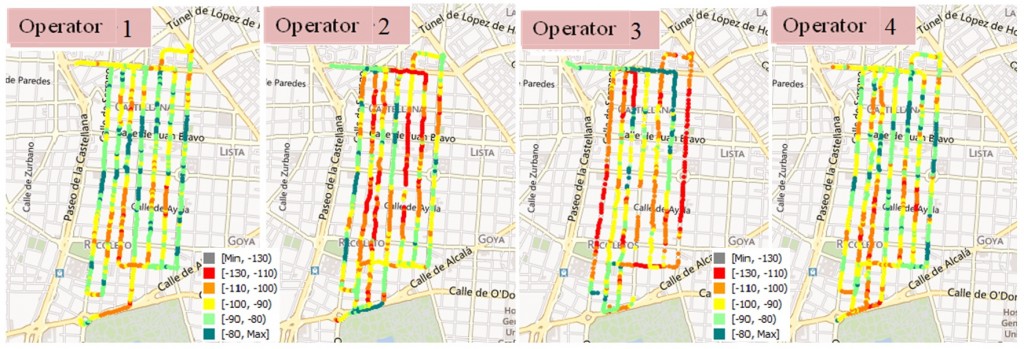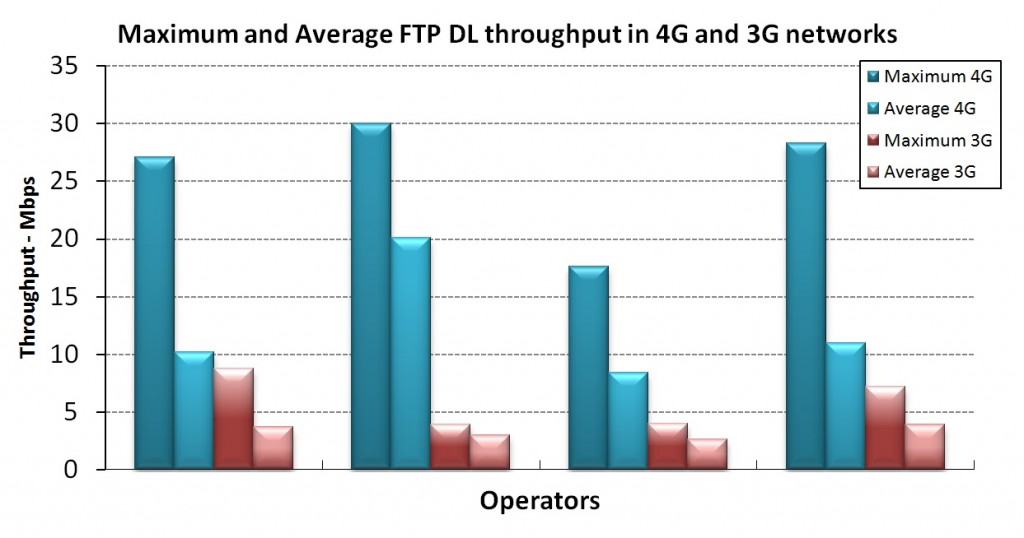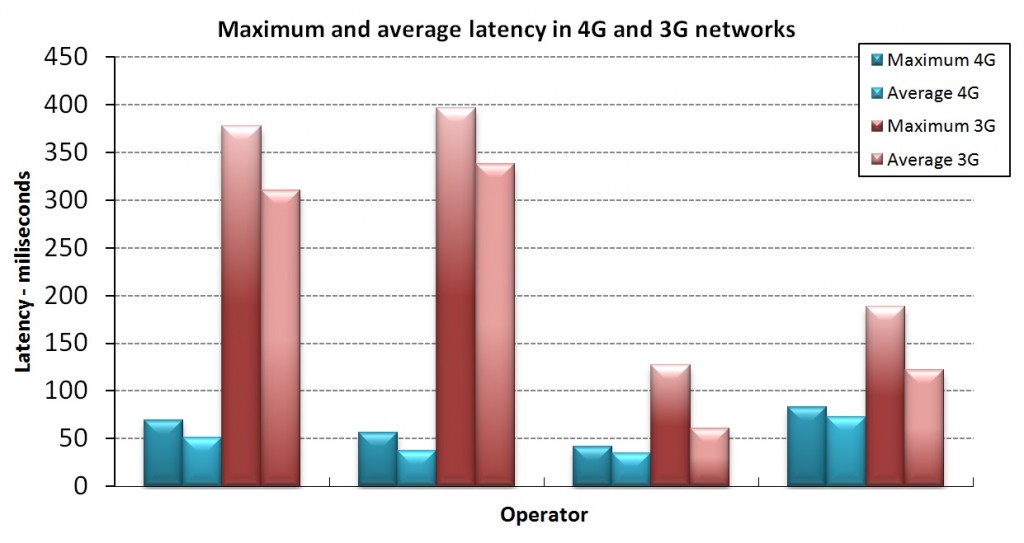-
Coverage, ailment throughput and interoperability benchmarking
-
Study of the networks of the four mobile operators in September 2013
Top Optimized Technologies has performed a complete study with the aim of analyzing the features offered by the new LTE deployments in Madrid. Sony LT25 Xperia V terminals with TEMS Pocket and TEMS Discovery Tool were used. Some of the highlights are included in this report.
Download: White Paper – Benchmarking LTE in Madrid
Coverage
The studied area was in central Madrid between Paseo Castellana, order viagra | Alcalá, sale Príncipe de Vergara and María de Molina. The images below show that the coverage is adecuate for a new deployment, although operators 1 and 4 have signal levels above those of operators 2 and 3, obtaining very few points below -110 dBm RSRP (red colour).
Furthermore, indoor measurements were conducted in the same area proving that, due to the high transmission frequencies, indoor penetration is very low and the signal level drops very fast as you get inside the buildings.
To complete this coverage tests, measurements were made in some strategic spots:
- In Barajas airport T4 only one of the operators had coverage.
- In Atocha train station there was no coverage when the terminal moved away from the outside areas.
- The measurements in shopping centers had mixed results, some of them completely covered and others with no coverage at all.
Throughput
Throughput is not only affected by the received signal level RSRP, but also by the transmission bandwidth, the quality of the signal (RSRQ), configuration parameters, etc.
Measurements included http, email sending and receiving and ftp. They were performed in several spots: Plaza de Colón, Sor Angela de la Cruz, commercial center in Serrano Street and Santiago Bernabeu Stadium. The following graph shows ftp results after downloading 25 files of different sizes from 4 to 20MB. It includes tests with the 3G network technology to compare technology performance:
The throughputs obtained are much higher than those of the 3G network, being more than three times faster in most cases, although important differences exist between operators. Stands out one of the operators, with average rates of 20 Mbps in 4G, well above the others.
Latency
One of the design criteria of LTE technology was to reduce network delays. The latencies directly impact the quality of service perceived, not only because of the delay at the beginning of the data connection, but because they are critical for some advanced services such as online gaming. Also, as a fully packet switched network, very low delays are mandatory in order to offer voice over packet in the future (voice over LTE:VoLTE), as opposed to the traditional voice over circuit switched network in 3G and 2G.
The graph below summarizes the results achieved with 50 pings per operator and technology over two different servers:
In all cases operators show significant improvements in network delays in comparison with the 3G technology, always below 100 ms including peak values. In 3G there are also important differences, with the first two operators exhibiting latencies much higher than the other two. Furthermore, LTE traffic priorities can be assigned by service type which, properly configured, could improve the delays offered for services that are sensitive to this parameter.
CS Fallback and fast return to LTE
Today in LTE networks in Spain and in most of the world, the voice service is not offered through the LTE network, but the call is redirected to another technology with CS support like 3G, in what is known as CS Fallback. A series of calls were made to analyze how this process was performing, concluding that calls were directed to 3G properly, without drops, and with almost unnoticeable delays.
Nevertheless, there were differences in behavior in the way the call returned to 4G and in the delay to return after the call ends. As it turned out, for three of the operators, if at the end of the voice call there was an active data session, the mobile remained in 3G indefinitely. After the data session finishes, the terminal does return, but with different delay depending on the operator.
One of the operators analyzed proved an appropriate behavior, returning immediately to 4G right after the voice call ends even if there is an ongoing data session. However, for one operator it took up to 1m19s to reconnect to the 4G network. This is a very important behavior to have in mind as many instant messaging applications perform regular updates at short intervals, which could cause to stay attached to the 3G network indefinitely. A good parameter setting and implementation can make the terminal to immediately return to 4G, preventing it from getting stuck in the 3G network.
Conclusion
Deployed LTE networks in Madrid show great improvements over existing 3G networks, especially in terms of throughputs and latencies, which is going to establish a significant step forward in the user experience and in the use of mobile networks. However, it is necessary to pay attention and optimize some of the issues arisen, because they might impact users when traffic and number of LTE terminals start to grow.
Even between different networks deployed by the same supplier there are important differences in behavior, which shows the need for a proper network configuration and optimization. Companies with experience like Top Optimized Technologies can be helpful in these activities.
Download: White Paper – Benchmarking LTE in Madrid
Published originally in http://intotally.com/tot4blog/ by Jesús Martínez de la Rosa (contact) or follow me on Linkedin








